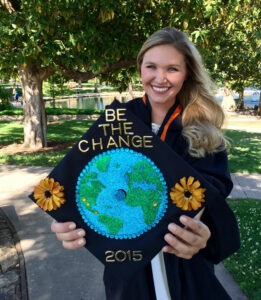 What do agriculture, African lions, and electric vehicles all have in common?
What do agriculture, African lions, and electric vehicles all have in common?
My background in agriculture at Oklahoma State University taught me that farmers were one of our nation’s first conservationists. Because their livelihoods directly depend on cultivating crops to feed the world, their success is dependent upon land quality – that conservation and promoting best land practices are key. Growing up in a suburban environment in Dallas/Fort Worth, TX, I was always in awe of my classmates’ deep connection to the land. I picked Environmental Science as a major solely because it was my favorite high school class. Though I was wholeheartedly interested in the subject matter and was considered “book smart,” I didn’t have a “boots on the ground” experience like my classmates, many of whom came from a long line of cattle ranchers and wheat farmers. It was one thing to learn about soil textures in a textbook, but it was entirely different to watch their traditional ecological knowledge unfold before my eyes in the field. From this interaction, I learned a deep sense for understanding human behavior and our connection to natural resources – a decision that landed me the opportunity to pursue a Master of Science in the Human Dimensions of Natural Resources college from Colorado State University.
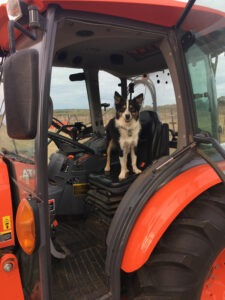 Although I was only there for a total of a year and a half, I feel as though living in Colorado changed my soul forever. There’s just something about the town of Fort Collins that is extremely intoxicating – if it’s not the smell of the crisp mountain air or the freshly hopped craft beer, it’s the feeling of being surrounded by like-minded outdoor enthusiasts who all enjoy the adventures and beauty of its wilderness. But perhaps it wasn’t the state that changed me, but my experiences through my Master’s program, Conservation Leadership. Because the program highly values cross-cultural and interdisciplinary perspectives, I traveled to Kenya for five months while conducting research for my Master’s thesis. After an extensive literature review, we identified five key domains and leadership strategies that promote successful conservation initiatives around the globe:
Although I was only there for a total of a year and a half, I feel as though living in Colorado changed my soul forever. There’s just something about the town of Fort Collins that is extremely intoxicating – if it’s not the smell of the crisp mountain air or the freshly hopped craft beer, it’s the feeling of being surrounded by like-minded outdoor enthusiasts who all enjoy the adventures and beauty of its wilderness. But perhaps it wasn’t the state that changed me, but my experiences through my Master’s program, Conservation Leadership. Because the program highly values cross-cultural and interdisciplinary perspectives, I traveled to Kenya for five months while conducting research for my Master’s thesis. After an extensive literature review, we identified five key domains and leadership strategies that promote successful conservation initiatives around the globe:
- Successful Stakeholder Engagement;
- Trust Within the Community;
- Internal “Champion” or community leader;
- Set Vision; and
- Effective Internal Processes/Communications.
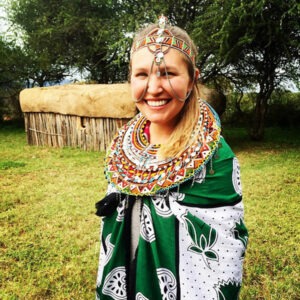 Instead of studying African lions on an ecological level, we applied our solidified conservation framework to a local Samburu NGO, Ewaso Lions, which helps protect the species. After numerous case studies and interviews with Ewaso Lions and its community members, it was clear that the organization possessed all of these key domains and more. From once an area of Northern Kenya whose inhabitants were forced to kill lions out of retaliation for attacking their livestock (the pastoralists’ main source of livelihood), Ewaso Lions was able to shift public attitudes and perceptions towards a favorable sentiment of African lions in the area. Currently, the lion population numbers in Northern Kenya are thriving, with the local Samburu people at the forefront of decision-making. After listening back to my interviews with the Ewaso Lions leadership team and local Samburu people, I couldn’t help but think back to my classmates at OSU. How many of my cattle ranching friends were also affected by looming predators causing human-wildlife conflict? Were there areas of this leadership framework and model that could be applied to conservation initiatives in the States? When I returned from Kenya, I aligned these same principles with my work in the U.S. – specifically studying the barriers to achieving sustainable behaviors with the City of Fort Collins. This experience ultimately landed me my first full-time position with the City of Austin, TX.
Instead of studying African lions on an ecological level, we applied our solidified conservation framework to a local Samburu NGO, Ewaso Lions, which helps protect the species. After numerous case studies and interviews with Ewaso Lions and its community members, it was clear that the organization possessed all of these key domains and more. From once an area of Northern Kenya whose inhabitants were forced to kill lions out of retaliation for attacking their livestock (the pastoralists’ main source of livelihood), Ewaso Lions was able to shift public attitudes and perceptions towards a favorable sentiment of African lions in the area. Currently, the lion population numbers in Northern Kenya are thriving, with the local Samburu people at the forefront of decision-making. After listening back to my interviews with the Ewaso Lions leadership team and local Samburu people, I couldn’t help but think back to my classmates at OSU. How many of my cattle ranching friends were also affected by looming predators causing human-wildlife conflict? Were there areas of this leadership framework and model that could be applied to conservation initiatives in the States? When I returned from Kenya, I aligned these same principles with my work in the U.S. – specifically studying the barriers to achieving sustainable behaviors with the City of Fort Collins. This experience ultimately landed me my first full-time position with the City of Austin, TX.
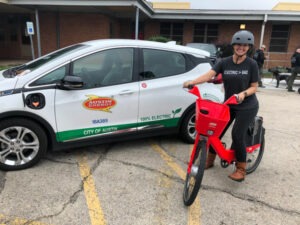 The City of Austin taught me that local matters. I learned the importance of partnerships, investing in relationships, and having key stakeholders involved in the conversation. When I accepted a role with the EV team at the utility, I had no idea how the technology worked! I didn’t have a background in engineering and was not an electrician. Instead, I used the same human dimension principles I learned in Fort Collins and tailored them to my work with EVs. My favorite part of the position was being able to play a role in shifting public attitudes and perceptions towards electric mobility (similar to how Ewaso Lions was able to shift perceptions favorably towards lions). I loved seeing members of the community’s “light bulb” moment when I equated “fueling” an EV with the same outlet they use to blow dry their hair or charge their phone. Additionally, I grew obsessed with watching the Innovation Diffusion Model that I studied in school shift before my eyes in just a few short years. It was certainly interesting to see the differences between the technology’s “Innovators” and “Early Adopters,” and how COVID-19 has played a part in the “chasm” period towards reaching the Early Majority. It was also from my time at the City of Austin that I learned that education is my passion, with my goal to reach all types of people and demographics when it comes to conservation awareness.
The City of Austin taught me that local matters. I learned the importance of partnerships, investing in relationships, and having key stakeholders involved in the conversation. When I accepted a role with the EV team at the utility, I had no idea how the technology worked! I didn’t have a background in engineering and was not an electrician. Instead, I used the same human dimension principles I learned in Fort Collins and tailored them to my work with EVs. My favorite part of the position was being able to play a role in shifting public attitudes and perceptions towards electric mobility (similar to how Ewaso Lions was able to shift perceptions favorably towards lions). I loved seeing members of the community’s “light bulb” moment when I equated “fueling” an EV with the same outlet they use to blow dry their hair or charge their phone. Additionally, I grew obsessed with watching the Innovation Diffusion Model that I studied in school shift before my eyes in just a few short years. It was certainly interesting to see the differences between the technology’s “Innovators” and “Early Adopters,” and how COVID-19 has played a part in the “chasm” period towards reaching the Early Majority. It was also from my time at the City of Austin that I learned that education is my passion, with my goal to reach all types of people and demographics when it comes to conservation awareness.
With a goal like that, it’s no surprise that I ended up at REACH Strategies! When I’m not educating communities about EVs in REACH’s EV101/201 courses, I am working with Recharge America’s partners to help ignite community-based innovation and embrace EV adoption. I am continually impressed by Recharge America’s focus on economic development and ensuring that those in rural communities are not left behind.
Going back to the conservation leadership framework I laid out through my grad program earlier, this is the exact model Recharge America uses to engage its participants
- We invest in relationships, communicate frequently with our participants, and establish clear roles and contributions (Stakeholder Engagement).
- We build EV awareness from the ground up with events focused on key players in the community leading the conversations (Trust).
- We engage not only important figures from the City and State, but also highlight individuals or groups integral to the community (Individual Champion).
- We have a clear vision that is shared by our partners, we highlight steps taken toward our goals through our recognition programs (Vision).
- Since we work across different communities nationally, we have the ability to see conservation issues at different scales and adapt to changing circumstances (Internal Process).
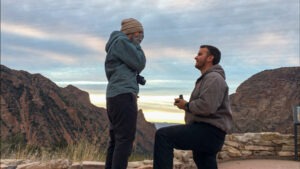 It is evident that my personality and interests are tied to the different places where I’ve spent the most time. I like to joke to my friends that I am divided into “thirds,” and last week I was thrilled to see my “rural” and “hippie” sides collide as one of our partners talked about converting their old gas pickups and farming equipment to electric gators and tractors instead. Could electrification be a game-changer in not only lowering greenhouse gas emissions but in merging the “gap” that sometimes comes with tackling complex conservation issues, as well? In the end, agriculture, African lions, and electric vehicles may not look connected from afar, but it’s the deeply interconnected web of successful conservation frameworks (like the one from my Master’s thesis) that link it. Just as African lions are keystone species in the animal kingdom, EVs have the potential to become a powerhouse in the mobility ecosystem as well.
It is evident that my personality and interests are tied to the different places where I’ve spent the most time. I like to joke to my friends that I am divided into “thirds,” and last week I was thrilled to see my “rural” and “hippie” sides collide as one of our partners talked about converting their old gas pickups and farming equipment to electric gators and tractors instead. Could electrification be a game-changer in not only lowering greenhouse gas emissions but in merging the “gap” that sometimes comes with tackling complex conservation issues, as well? In the end, agriculture, African lions, and electric vehicles may not look connected from afar, but it’s the deeply interconnected web of successful conservation frameworks (like the one from my Master’s thesis) that link it. Just as African lions are keystone species in the animal kingdom, EVs have the potential to become a powerhouse in the mobility ecosystem as well.
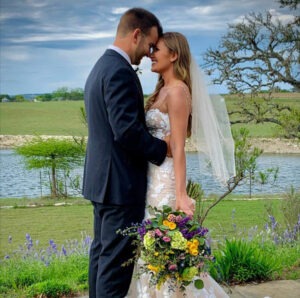
Also – I did marry a farmer! A wine grape farmer (Vineyard Manager), that is. When I’m not working with electric vehicle adoption on the weekdays, I’m working with him on Saturday’s pouring wine from the grapes he helped grow. We like hanging out with our pups Indie and Dash in our downtime, and love to travel! Before attempting to see more countries overseas, our goal is to explore the wonders of all of America’s pristine National Parks (we got engaged at Big Bend & honeymooned at Glacier, North Cascades, Olympic, and Mt. Rainier this past summer). And you better bet that owning the F-150 Lightning is in our (hopefully not so distant) future!
Caitlin Fletcher
Conservation Specialist | Program Strategist, REACH Strategies | Connecting people with planet through innovation, emerging technologies, and sustainable solutions
